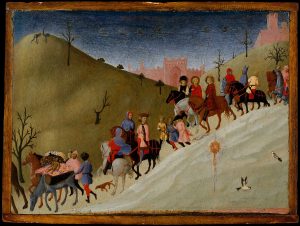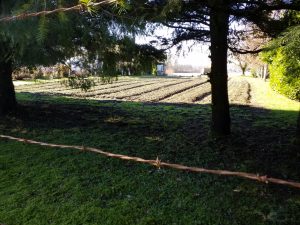1. Why does King create dichotomies for us to examine these two creation stories? . . . What is he trying to show us?
I’m dying to remind myself that the basis of Christian doctrine is rectitude and reward, crime and punishment, even though my partner has warned me that this is probably not a good idea. Tell a story, she told me. Don’t preach. Don’t try to sound profound. It’s unbecoming, and you do it poorly. Don’t show them your mind. Show them your imagination.
So am I such an ass as to disregard this good advice and suggest that the stories contained within the matrix of Christianity and the complex of nationalism are responsible for the social, political, and economic problems we face? Am I really arguing that the martial and hierarchical nature of Western religion and Western privilege has fostered stories that encourage egotism and self-interest? Am I suggesting that, if we hope to create a truly civil society, we must first burn all the flags and kill all the gods, because in such a world we could no longer tolerate such weapons of mass destruction?
No, I wouldn’t do that. (King 26-7)
And yet, Thomas King has already made these suggestions, in a somewhat disingenuous way (a rhetorician might call this apophasis), by invoking and discarding them. Nor does he discard them very definitively; he says that he “wouldn’t do that” as though he could well or would very much like to. Indeed, his casual rewriting of Genesis seems to support rather than detract from these disavowed claims.
I quote King at length here to exhibit my moments of greatest struggle with his text, and to acknowledge my instincts of dissent and defensiveness. I know that full-fledged Christian apologetics are not what is called for here. This is why I appreciate Dr. Paterson’s invitation to read beyond the dichotomies King seems to be setting up and consider why he might be doing so.
Although we haven’t reached the novel yet in our course of work for the term, I can’t help relating my thinking and feeling about this question to what King does in Green Grass, Running Water. When I read the book three years ago, I found it quite brilliant, provocative, clever, and on the whole enjoyable (and I mean this in a non-trivial way: the novel manages to be extremely fun, stimulating, affecting, and at times surprisingly inspiring). This reading—perhaps the intervening years of study have made me more prone and confident to question!—I find myself more troubled and challenged by what seems like an insistent belittling of Christian myth. In fact, the novel affects to collapse a Christian narrative into its Coyote-story (or Coyote-stories), more or less as a silly or aberrant offshoot (a rogue dream).
This strategy of collapse is no less surprising than the simplistic dichotomising he seems to carry out in The Truth About Stories; both suggest a basic dualism that seems quite far from the intellectual and ethical projects of J. Edward Chamberlin and even John Lutz. They are concerned with finding common ground between systems of story and the understandings they support, not with establishing moral hierarchies between them or writing them off as pernicious.
True, even their projects must involve some reduction and simplification. Upon reflection, I don’t think the complex of stories underpinning a single individual, much less a “society,” could really be entirely articulated and examined.
In that sense, it’s really rather peculiar that King should characterize the spiritual, mythical, narrative discourse(s) of Christianity as “monolog[ical]” (21). As though there were ever a supposed cultural monolith as drastically heterogeneous, fragmentary and debated! This reminds me of the German philosopher Odo Marquard in his thinking about “polymyths” and “monomyths” (88). For Marquard, the polymyth (analogous with polytheism) is harmless and therefore desirable; the multiple stories, gods, and powers keep each other in check so that no one of them has absolute sway. It’s the monomyth you have to look out for (93).
Yet Lutz and Wendy Wickwire help us to see that, practically speaking, we’re not dealing with a simple static dichotomy of monomyth vs polymyth but with fluid, changing, constantly renegotiated contact zones, meetings of horizons in which different (but perhaps not wholly incommensurable) stories meet. Values and outcomes are always somewhat complex and unclosed to begin with: as with the adoption of pre-Christian stories and practices into instantiations of the Christian mythos, or the mixture of Christian and courtly values in medieval romance, or indeed the European elements in post-contact stories of North-West coast Indigenous peoples. These cases are not to be dismissed (as post-contact stories were by anthropologists) for not fitting the type, but rather valued as ambiguous places of intersection displaying the extraordinary complexity of belief.
Ambiguous or, to use King’s word, enigmatic. These are areas of imperfect understanding and (as Chamberlin would point out) constant contradiction (115). Perhaps they carry the good news that we don’t have to be—can’t be—entirely consistent. Can only one story really be sacred and true?
There’s a story about a little girl who asks her mother where they came from. The mother replies, “God made us on the seventh day of creation.” The girl, still unsure, asks her father the same question. His answer—“We evolved from apes.” Now she’s more confused than ever. She goes back to her mother and says, “You told me that God made us and Dad said we evolved from apes. I don’t understand—which one’s true?” “They’re both true, honey,” her mother responds, “your father’s just talking about his side of the family.”
A resolution and no resolution at all. Chamberlin would have us see that we can and do believe in both, and that this isn’t just a result of muddled thinking. In fact, sometimes it can be the result of humour and irony. Lutz notes that Indigenous storytellers often use humour and irony to “challenge and reorder hierarchies of power” (13). Maybe what King is doing is using humour to point out the radical contingency of the stories we live by, the telling of them, and even the analytical models we use to discuss them. They didn’t need to be this way. And changing the telling or the valuation can have genuine transformative power. Laughter, which may be as close to a cultural universal as it gets, may be a potent means of finding common ground. At least, being able to laugh at ourselves may have a certain value.
Works Cited
Beard, Mary. “A history of laughter – from Cicero to The Simpsons.” The Guardian, 28 June 2014, https://www.theguardian.com/books/2014/jun/28/history-laughter-roman-jokes-mary-beard. Accessed 22 February 2021.
Chamberlin, Edward. If This is Your Land, Where are Your Stories? Finding Common Ground. Knopf, 2003.
King, Thomas. Green Grass, Running Water. Harper Collins, 1993.
—. The Truth About Stories: A Native Narrative. Anansi Press, 2003.
Lutz, John. “First Contact as Spiritual Performance.” Myth and Memory: Rethinking Stories of Indigenous-European Contact, edited by John Lutz, University of British Columbia Press, 2007, pp. 30-45.
—. Introduction. “Contact Over and Over Again.” Myth and Memory: Rethinking Stories of Indigenous- European Contact, edited by John Lutz, University of British Columbia Press, 2007, pp. 1-15.
Marquard, Odo. “In Praise of Polytheism.” Farewell to Matters of Principle : Philosophical Studies, Oxford University Press, 1989. ProQuest, http://ebookcentral.proquest.com/lib/ubc/detail.action?docID=271453. Accessed 15 June 2020.
Marty, Martin E. “Fractured Christian World(s).” The University of Chicago Divinity School, 18 January 2016, https://divinity.uchicago.edu/sightings/articles/fractured-christian-worlds. Accessed 22 February 2021.
Wickwire, Wendy. Introduction. Living by Stories: a Journey of Landscape and Memory, compiled and edited by Wendy Wickwire, Talon Books, 2005, pp. 1-30.


